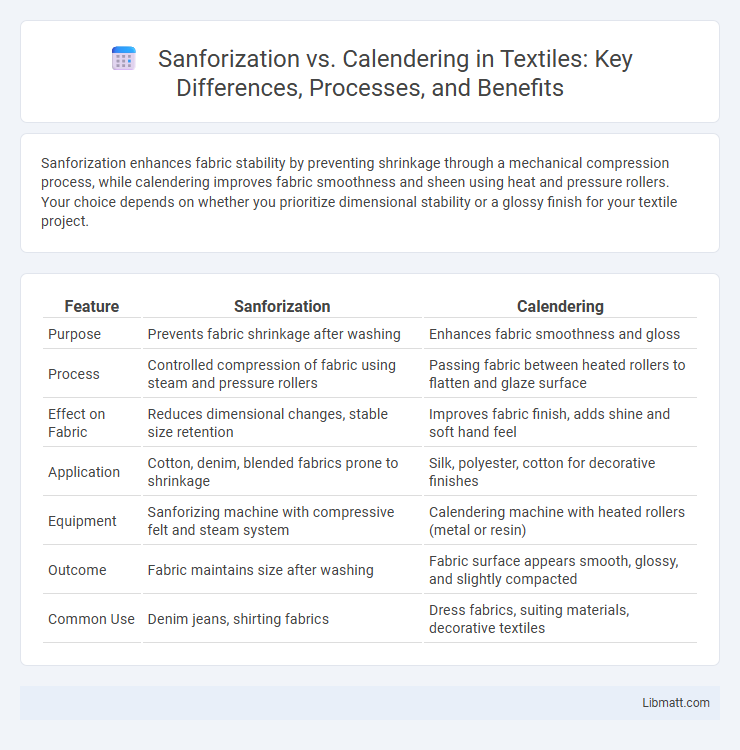Sanforization enhances fabric stability by preventing shrinkage through a mechanical compression process, while calendering improves fabric smoothness and sheen using heat and pressure rollers. Your choice depends on whether you prioritize dimensional stability or a glossy finish for your textile project.
Table of Comparison
| Feature | Sanforization | Calendering |
|---|---|---|
| Purpose | Prevents fabric shrinkage after washing | Enhances fabric smoothness and gloss |
| Process | Controlled compression of fabric using steam and pressure rollers | Passing fabric between heated rollers to flatten and glaze surface |
| Effect on Fabric | Reduces dimensional changes, stable size retention | Improves fabric finish, adds shine and soft hand feel |
| Application | Cotton, denim, blended fabrics prone to shrinkage | Silk, polyester, cotton for decorative finishes |
| Equipment | Sanforizing machine with compressive felt and steam system | Calendering machine with heated rollers (metal or resin) |
| Outcome | Fabric maintains size after washing | Fabric surface appears smooth, glossy, and slightly compacted |
| Common Use | Denim jeans, shirting fabrics | Dress fabrics, suiting materials, decorative textiles |
Introduction to Fabric Finishing Techniques
Sanforization is a fabric finishing technique designed to prevent shrinkage by compressing the fabric through controlled moisture and heat, ensuring dimensional stability in cotton and cotton-blend textiles. Calendering involves passing fabric through heated rollers to impart a smooth, glossy finish, enhancing the surface appearance and texture of materials like polyester and silk. Both processes improve fabric quality but target different characteristics: Sanforization stabilizes size while calendering enhances luster and smoothness.
What is Sanforization?
Sanforization is a fabric pre-shrinking process that stabilizes woven textiles, preventing significant shrinkage after washing. It involves moistening, stretching, and compressing the fabric using a specialized machine to ensure dimensional stability. Your garments maintain their size and fit, enhancing durability and customer satisfaction.
What is Calendering?
Calendering is a textile finishing process that involves passing fabric between heated rollers to smooth, compress, and enhance its surface appearance. This technique improves fabric density, imparts a glossy or matte finish, and can add texture or patterns depending on roller design. Your fabric gains enhanced durability and aesthetic appeal through calendering, distinguishing it from processes like sanforization, which primarily focus on shrinkage control.
Process Comparison: Sanforization vs Calendering
Sanforization involves pre-shrinking fabric using a controlled compression process to stabilize dimensions and prevent future shrinkage, typically applied to cotton and denim materials. Calendering, on the other hand, employs high-pressure rollers to smooth and enhance fabric surface properties, resulting in a glossy finish and improved texture, often used for polyester and blended fabrics. While Sanforization targets dimensional stability, Calendering focuses on aesthetic and tactile enhancement.
Key Benefits of Sanforized Fabrics
Sanforized fabrics undergo a controlled process that significantly reduces shrinkage, ensuring that your garments maintain their original size and fit after washing. This process enhances fabric stability and durability compared to calendering, which primarily improves surface smoothness and luster but does not address shrinkage. As a result, sanforized textiles provide superior comfort and long-lasting wear, making them ideal for high-quality apparel.
Key Advantages of Calendered Fabrics
Calendered fabrics offer enhanced smoothness and a high-gloss finish that improves aesthetic appeal and fabric hand. The calendering process increases fabric density and surface uniformity, resulting in improved durability and resistance to pilling or abrasion. Moreover, calendered fabrics exhibit better dimensional stability and enhanced water repellency, making them ideal for technical and fashion applications.
Differences in Application and End Uses
Sanforization primarily targets cotton and denim fabrics to prevent shrinkage during washing, ensuring dimensional stability for garments like jeans and casual wear. Calendering applies heat and pressure to various woven and non-woven fabrics, producing a smooth, glossy finish commonly used in bed linens, uniforms, and home textiles. The key difference lies in Sanforization's focus on fabric stability, while Calendering emphasizes enhancing surface appearance and texture.
Durability and Performance: A Comparative Analysis
Sanforization enhances fabric durability by minimizing shrinkage and maintaining dimensional stability during washing, resulting in consistent garment performance over time. Calendering improves fabric surface smoothness and luster but does not significantly impact shrinkage control or long-term durability. Fabrics treated with sanforization exhibit superior resistance to deformation and wear, making them more reliable for high-performance applications compared to calendered fabrics.
Environmental Impact and Sustainability
Sanforization reduces fabric shrinkage through controlled compression, using less water and energy compared to traditional washing, making it more environmentally sustainable. Calendering, involving high-temperature rollers to smooth fabric surfaces, consumes significant energy and may utilize chemicals that contribute to environmental pollution. Prioritizing Sanforization in textile production supports sustainable practices by lowering resource consumption and chemical use.
Which Process is Best for Your Textile Needs?
Sanforization stabilizes fabric by preventing shrinkage through controlled compression, making it ideal for maintaining garment size and durability. Calendering enhances fabric appearance by applying heat and pressure to create a smooth, glossy finish, best suited for textiles requiring an elegant look. Your choice depends on whether you prioritize dimensional stability with Sanforization or aesthetic appeal with Calendering.
Sanforization vs Calendering Infographic

 libmatt.com
libmatt.com